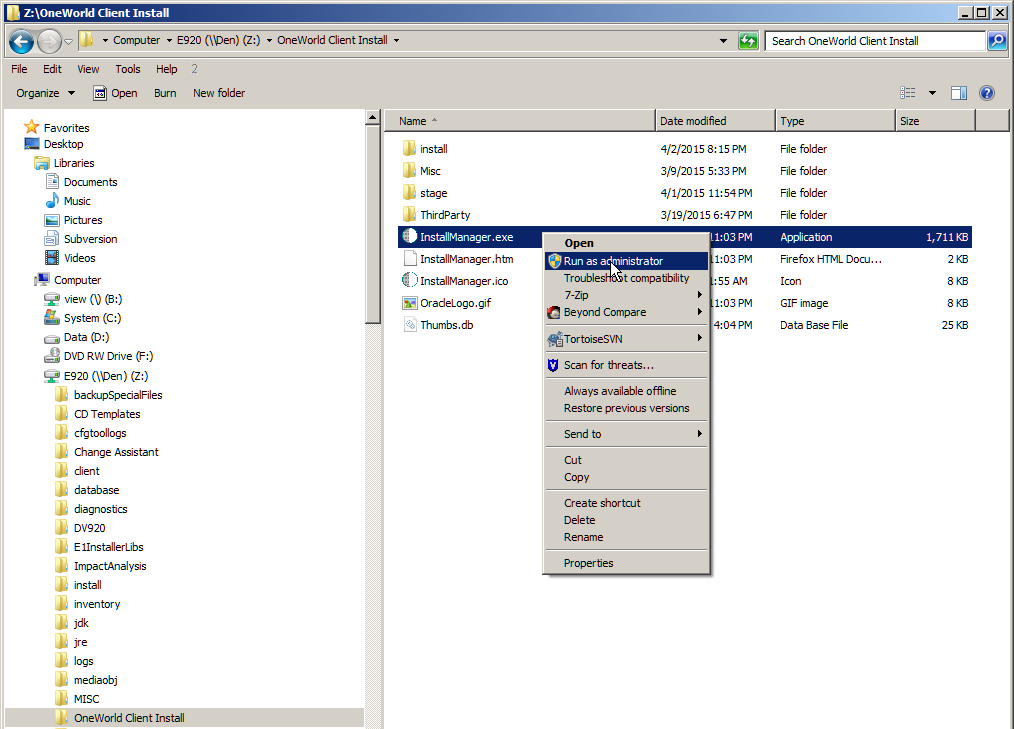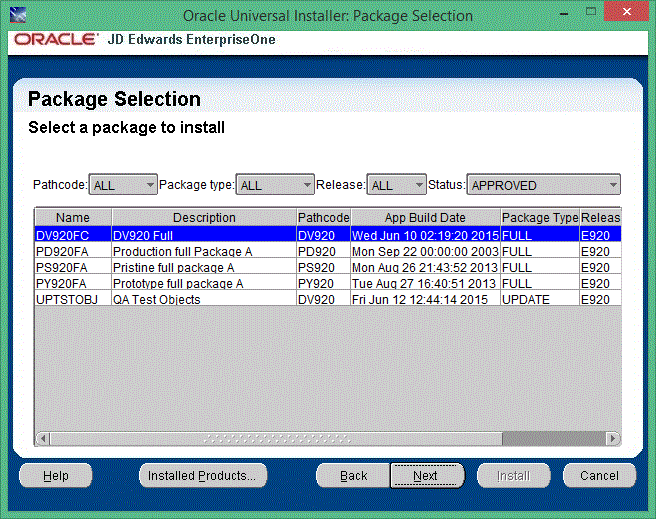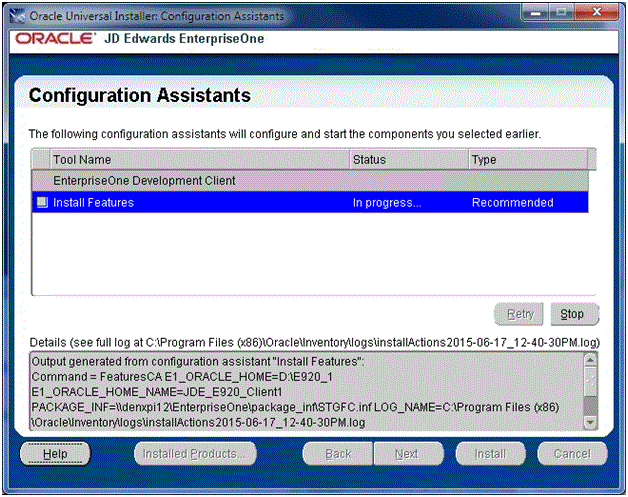Installing the Development Client
The InstallManager program is the JD Edwards EnterpriseOne front-end program used to launch the OUI installer for the Development Client. Locate and run this program as described below.

- Run this program:
\\<deployment server name>\<release>\OneWorld Client Install\InstallManager.exeCaution:You must right-click on the executable and select Run as Administrator from the drop-down. Likewise, if you have a shortcut assigned to
InstallManager.exe, you must either configure the shortcut to automatically Run as Administrator or right click the shortcut and choose Run as Administrator. - Click this link to install the JD Edwards EnterpriseOne Development
Client:
EnterpriseOne E920 Client

- On Welcome, click the Next button.

- On Specify Home Details, you must specify an Oracle Home path and a
name for that path.
Each Oracle product that is installed on a machine has what is termed an Oracle Home path. This path contains all the files for each Oracle product. This path has a user-specified name as well.
Caution:Do not specify the same Oracle Home name or path into which you installed a local OEE database.
Note:The OUI installer appends a number to the ends of the default Oracle Home name and path. This number is initially "1." If an Oracle Home already exists with the given default name and path, the OUI installer increments this number in both the name and path.
You do not have to take the default values; you can enter your own name and path values.
Note:If you have an existing installation of the Development Client and you want to perform another installation on the same machine, you have several options:
- Select the same Oracle Home as the existing Development Client.
- If the package that you select is an update package, the existing Development Client will be updated with files and data from the update package.
- If the package that you select is a full package and the pathcodes of the package and the existing Development Client are the same, components of the existing Development Client will be removed before the new package is installed.
- If the package that you select is a full package and the pathcodes of the package and the existing Development Client are NOT the same, the pathcode of the existing Development Client will remain, and the new package will be installed giving you multiple pathcodes.
- Uninstall the existing Development Client before installing the new one.
- Run SnapShot and save the existing Development Client before installing the new one.
Additional information is included in Installing Multiple Pathcodes.
- Select the same Oracle Home as the existing Development Client.
- Click the Next button.

- On Package Selection, select the appropriate package for the Development
Client.Note:
If the Package Selection screen includes multiple Development Client installation packages, for either the Oracle WebLogic Application Server, WebSphere Express, or WebSphere 9.0, be sure to select the package for the application server you are using.
Note:You may filter the list of packages using the combo boxes above the table. You can also sort the list of packages by clicking on a column header.
Note:See Installing Multiple Pathcodes for information about installing multiple pathcodes on your workstation.
- Click the Next button.

- On Install Mode, select the type of JD Edwards EnterpriseOne (E1) objects to install:
-
Development
These are needed if you plan to modify E1 objects such as business functions, applications, forms, etc.
-
Production
Select this type if you do not plan to modify E1 objects.
If you selected an update package, you will not see this screen. The install mode will be the same as the already installed full package.
-
- Click the Next button.Note:
If you selected an update package that includes specs, you will be prompted for an E1 user and password.

- On Summary, verify that what will be installed is what you expect.
-
The "Space Requirements" in the upper half of the window show the space that OUI requires for its support files. This space does not include the size of the package that you selected.
-
The "Package Disk Space Requirements" shown in the lower half of the window are for the package being installed.
-
If this is an update package or you are installing into an existing Development Client's Oracle Home, the value for the "Package Disk Space Requirements" does not include disk space of the existing installed package. Because some components of the new package may replace existing components or be installed in addition to existing components, the package value may be lower or higher than the actual amount of required disk space.
-
- Click the Install button.

If the package you are installing contains a Web Client Feature for WLSH4A or WASH4A, the above screen is displayed near the end of the installation, At this point, the Development Client installer spawns additional installers. Which installers are run depends on which features were included in the package that you selected. Those features were specified by the person that created the package.
As the Configuration Assistants spawned installers run, the OUI installer displays the name of the log file at the bottom of the screen in "Details (see full log at ...". If you do not note the location of the log before the message or screen closes, you can find the installation logs in one of these directories:
- 64-bit Development Client
C:\Program Files\Oracle\Inventory\logs - 32-bit Development Client
C:\Program Files (x86)\Oracle\Inventory\logs
When you display that directory using Windows Explorer, you should sort the contents by date. The results of each installation will be logged in three files, all with the same date_time in their names, but with different file extensions:
-
.log -
.err -
.out
For information about the WLSH4A installer, refer to the section of this guide entitled: Installing the WebLogic Web Client (WLSH4A).
- 64-bit Development Client